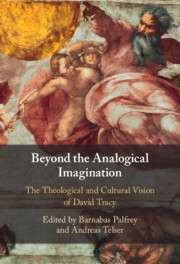Book contents
- Beyond the Analogical Imagination
- Reviews
- Beyond the Analogical Imagination
- Copyright page
- Epigraph
- Contents
- Contributors
- Acknowledgements
- Introduction
- Part I Theology and Culture
- Part II Public and Beyond
- Part III Church and World
- Part IV From David Tracy
- Part V Post-Script
- Chapter 12 David Tracy’s Constructive Theology
- Bibliography
- Index
Chapter 12 - David Tracy’s Constructive Theology
Impressions, Contours, Conversations
from Part V - Post-Script
Published online by Cambridge University Press: 28 September 2023
- Beyond the Analogical Imagination
- Reviews
- Beyond the Analogical Imagination
- Copyright page
- Epigraph
- Contents
- Contributors
- Acknowledgements
- Introduction
- Part I Theology and Culture
- Part II Public and Beyond
- Part III Church and World
- Part IV From David Tracy
- Part V Post-Script
- Chapter 12 David Tracy’s Constructive Theology
- Bibliography
- Index
Summary
David Tracy’s work invites readers generously into ever-widening conversations while Tracy himself pursues a precise theological ‘pointilism’ calling for lengthy rumination. Tracy’s concept of the ‘classic’– cultural, religious, theological– is endlessly fruitful for theology amid plural and ambiguous history. Tracy’s work may be viewed as an attempt at ‘making the future of theology now’, adumbrating theological possibility in a complicated and complicating present. Tracy’s major early works– Blessed Rage for Order (1975) and The Analogical Imagination (1981)– quite radically reconceived theology for greater present-day self-awareness, yet equally Tracy’s concept of analogical imagination calls to mind the ‘third way’ between cataphasis and apophasis that Dionysius the Areopagite pretended to have written as his Symbolic Theology. Tracy’s recent essay collections, Fragments and Filaments, reprise the theological experience of reading Tracy. As fragments and filaments (‘ever unreeling … ever tirelessly speeding’– Walt Whitman), these mutually resonating essays quicken into theological events for readers who learn to read well, with Tracy, to ‘make the future of theology now’.
- Type
- Chapter
- Information
- Beyond the Analogical ImaginationThe Theological and Cultural Vision of David Tracy, pp. 223 - 241Publisher: Cambridge University PressPrint publication year: 2023

